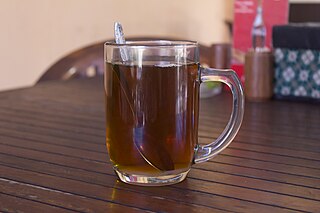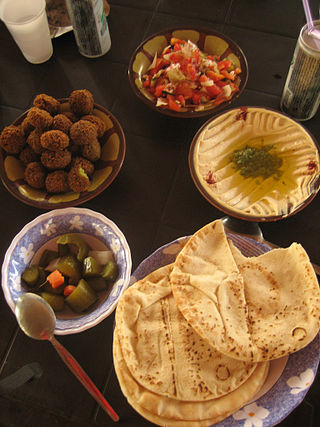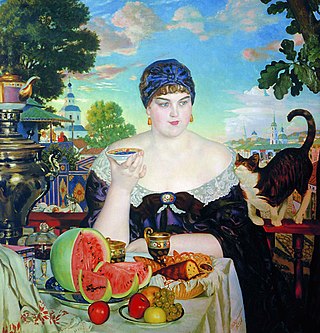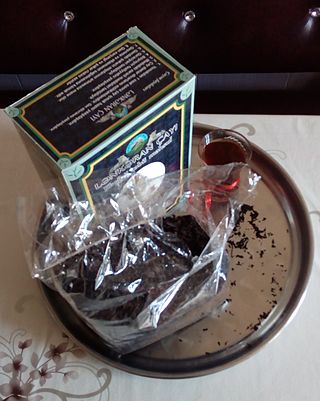
A drink or beverage is a liquid intended for human consumption. In addition to their basic function of satisfying thirst, drinks play important roles in human culture. Common types of drinks include plain drinking water, milk, juice, smoothies and soft drinks. Traditionally warm beverages include coffee, tea, and hot chocolate. Caffeinated drinks that contain the stimulant caffeine have a long history.
Albanian cuisine is a representative of the cuisine of the Mediterranean. It is also an example of the Mediterranean diet based on the importance of olive oil, fruits, vegetables and fish. The cooking traditions of the Albanian people are diverse in consequence of the environmental factors that are more importantly suitable for the cultivation of nearly every kind of herbs, vegetables and fruits. Olive oil is the most ancient and commonly used vegetable fat in Albanian cooking, produced since antiquity throughout the country particularly along the coasts.
Rakija, rakia, rachiu, rakı or rakiya, is the collective term for fruit spirits popular in the Balkans. The alcohol content of rakia is normally 40% ABV, but home-produced rakia can be stronger.

Russian cuisine is a collection of the different dishes and cooking traditions of the Russian people as well as a list of culinary products popular in Russia, with most names being known since pre-Soviet times, coming from all kinds of social circles.

Maghrebi mint tea, also known as Moroccan mint tea and Algerian mint tea, is a North African preparation of gunpowder green tea with spearmint leaves and sugar.

Tea culture is defined by how tea is made and consumed, how people interact with tea, and the aesthetics surrounding tea drinking.

Czech cuisine has both influenced and been influenced by the cuisines of surrounding countries and nations. Many of the cakes and pastries that are popular in Central Europe originated within the Czech lands. Contemporary Czech cuisine is more meat-based than in previous periods; the current abundance of farmable meat has enriched its presence in regional cuisine. Traditionally, meat has been reserved for once-weekly consumption, typically on weekends.

Spoon sweets are sweet preserves, served in a spoon as a gesture of hospitality in Bosnia, Serbia, Albania, Greece, Turkey, Kosovo, Cyprus, the Balkans, parts of the Middle East, and Russia. They can be made from almost any fruit, though sour and bitter fruits are especially prized. There are also spoon sweets produced without fruit.

Tea is a popular drink throughout Turkey and the Turkish diaspora. Turkey has the highest per capita tea consumption in the world with an annual total consumption of over 3 kilograms per person. Turkey is a large exporter of tea, ranking fifth among the top exporting countries. Tea plays a big role in social gatherings that take place in tea houses and gardens. It is also used as a herbal medicine. Turkish tea culture extends to Northern Cyprus and some countries in the Balkan Peninsula. Turkish tea has a long and expansive history that shaped its harvesting even before the founding of the modern Turkish Republic. Since its introduction to Turkey, tea has become a large part of Turkish culture.
Azerbaijani cuisine is the cooking styles and dishes of the Republic of Azerbaijan. The cuisine is influenced by the country's diversity of agriculture, from abundant grasslands which historically allowed for a culture of pastoralism to develop, as well as to the unique geographical location of the country, which is situated on the crossroads of Europe and Asia with access to the Caspian Sea. The location has enabled the people to develop a varied diet rich in produce, milk products, and meat, including beef, mutton, fish and game. The location, which was contested by many historical kingdoms, khanates, and empires, also meant that Azerbaijani cuisine was influenced by the culinary traditions of multiple different cultures, including Turkic, Iranian, and Eastern European.

Tajik cuisine is a traditional cuisine of Tajikistan, and has much in common with Russian, Afghan, Iranian and Uzbek cuisines. Plov (pilaf), also called osh, is the national dish in Tajikistan, as in other countries in the region. Green tea is the national drink.

Jordanian cuisine is a Levantine cuisine developed over time in Jordan. Stuffed vegetables are common, with many different techniques employed in their preparation. Meat is an important component of Jordanian cuisine, most often lamb, beef and chicken but also goat and camel meat. Rice is frequently served as a side dish but there are also one-pot rice dishes such as maqloubah.

Tea is an important part of Russian culture. Due in part to Russia's cold northern climate, it is today considered the de facto national beverage, one of the most popular beverages in the country, and is closely associated with traditional Russian culture. Russian tea is brewed and can be served sweet, and hot or cold. It is traditionally taken at afternoon tea, but has since spread as an all day drink, especially at the end of meals, served with dessert. A notable aspect of Russian tea culture is the samovar, which was widely used to boil water for brewing until mid-XX century.

Armudu or Armudu stəkan, sometimes called Boğmalı is a kind of drinking glass used for black tea in Azerbaijan. It is similar to the Turkish traditional tea glass called ince belli bardak.

Qatari cuisine is made up of traditional Arab cuisine. Machbūs, a meal consisting of rice, meat, and vegetables, is the national dish in Qatar, typically made with either lamb or chicken and slow-cooked to give it a depth of flavour. Seafood and dates are staple food items in the country. Many of these dishes are also used in other countries in the region because they share many commonalities. In other parts of the region, some of the dishes have different names or use slightly different ingredients. One proponent of the importance of Qatar's culinary heritage is chef Noor Al Mazroei, who adapts traditional recipes to include vegan and gluten-free alternatives.

Sharbat is a drink prepared from fruit or flower petals. It is a sweet cordial, and usually served chilled. It can be served in concentrated form and eaten with a spoon or diluted with water to create the drink.

Arabic tea (Arabic: شاي عربي, romanized: šāy ʿarabiyy, (pronounced shay, is a variety of hot teas popular throughout the Arab world. It is commonly served to guests and business partners at meetings and social events, and has been drunk by Arab people for centuries.
National traditions are well preserved in Azerbaijan. They have a long history, namely originates from the formation of the Azerbaijani people. There are several traditions in Azerbaijan, some customs and traditions differ from region to region.

Tea growing in Azerbaijan is concentrated in an area of 5.33 thousand square kilometers located within the Lenkeran-Astara region, including the districts of Astara, Lankaran, Masalli, Lerik, Yardimli, and Jalilabad. Around 90% of Azerbaijan's tea is produced in Lankaran close to the southern border with Iran. Tea was first grown around the Caspian Sea region of Azerbaijan in the 1880s. Due to its favorable climatic conditions, the region now produces 99% of the Azerbaijani tea crop.
















